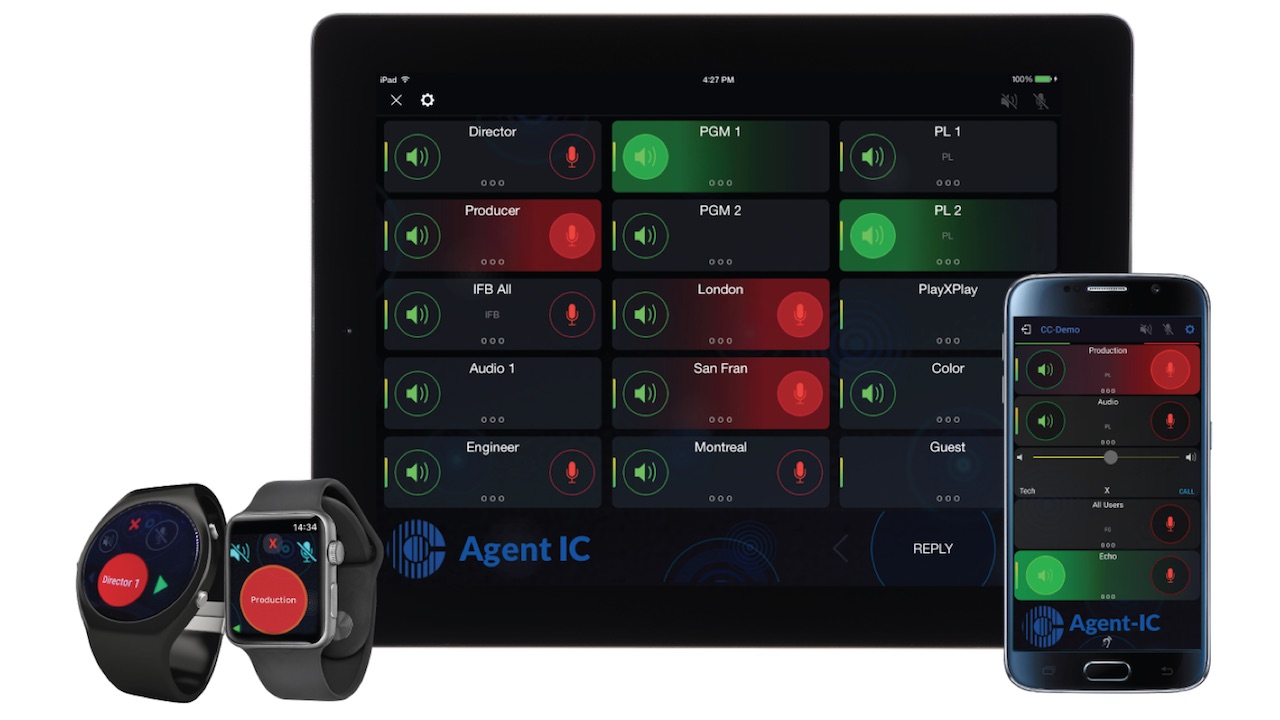Clear-Com’s Agent-IC mobile app is helping productions around the world operate from the homes of staff and on-screen talent due to the COVID-19 pandemic. The app for iOS and Android turns smartphones, tablets, and wearable devices into fully featured intercom panels with connectivity over Wi-Fi, 3G, 4G, and LTE networks.
“Clear-Com has always had a broad offering of products and solutions for various workflows and working conditions,” said Bob Boster, president, Clear-Com. “While it would be fair to say we never imagined our current scenario, Agent-IC is providing a simple yet highly effective solution to help production teams working from home all over the world stay connected.”
Related: NewTek Ships Latest TriCaster Mini 4K With Tools for Small Production Teams
Since its launch in 2015, Agent-IC has been used as a communication solution between facility-based staff and production teams on location for field reporting, live event production, remote coordination, and other critical tasks. Local and remote LQ devices can access up to 48 Agent-IC users, where LQ acts as a server for the app. With a Clear-Com’s Eclipse mainframe in the studio, many more Agent-IC users can access the production intercom remotely—the number of users able to access the main intercom can vary depending on the quantity of IP ports on the E-IPA cards.
Broadcast stations of varying sizes throughout the world, including Verizon Media, Philadelphia’s WFMZ/WDPN-TV and Germany’s Home Shopping Europe (HSE24), are now looking to Agent-IC to meet their production needs from home, and in the last two weeks alone, more than 30 customers have added the app to their networks, according to Clear-Com.
For Verizon Media, the adaptive connectivity of its Eclipse frame has allowed production teams to take advantage of their Agent-IC mobile clients, granting full remote access to connect comms to their base intercom system without having anyone in the studio.
“Agent IC has been the communications glue that has allowed Yahoo Finance and Verizon Media to run fully remote productions during the current COVID-19 situation in New York City—a lifesaver,” said Dan Brantigan, Verizon Media’s head of audio.
HSE24 is using Agent-IC as a full-fledged intercom system and for in-ear monitoring, connecting live experts to the bidirectional intercom lines from the main studio to the other external locations. They have been integrating additional Agent-IC licenses into their existing Eclipse intercom system on a need-basis, which has proven to be a cost-effective and easy-to-deploy solution.
“Due to the current situation we had to move some of our live productions to remote offices,” said Norbert Wilinski, broadcast engineer for HSE24. “Thanks to the seamless integration of Clear-Com’s Agent-IC app, remote staff were able to continue producing live content, maintaining our usual workflow and guaranteeing real-time command.”
Jeff Kuhns at WFMZ/WDPN-TV also recognized the practicality and convenience of Agent-IC in today’s circumstances. “With our company requiring our news producers to work from home, Agent-IC has been a vital key to our success and our staff is amazed with the flexibility it has given them. Having a full intercom panel on their mobile device allows them to interact with our production team, news anchors, ENG crews and reporters in real time, from their home office. It’s a vital tool for today’s work environment.”
Multiple options for connectivity help staff in choosing the best option for their geographic location and time of day, depending on local broadband speeds. 3G, 4G, LTE and Wi-Fi network operation allows for load balancing of interaction with the studio—without necessarily using the same network resources as the editing tools—and can help secure communications without endangering the higher bandwidth required for program content such as video and graphics.
“It is important to note that while these home adaptations of intercom systems are crucial in today’s work-from-home landscape, Agent-IC is not likely to replace conventional workflows once this crisis subsides,” Boster clarified. “Not everyone has the space to accommodate the remote production of a sporting event, for example, that can take up to 10 hours, and there are latency issues to address while on Wi-Fi that could be a concern for program content. But for this situation, it is a great interim solution,” he said.
